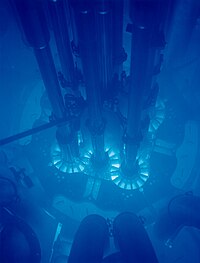
Photo from wikipedia
Abstract. Purpose: Unlike fluorescence imaging utilizing an external excitation source, Cherenkov emissions and Cherenkov-excited luminescence occur within a medium when irradiated with high-energy x-rays. Methods to improve the understanding of… Click to show full abstract
Abstract. Purpose: Unlike fluorescence imaging utilizing an external excitation source, Cherenkov emissions and Cherenkov-excited luminescence occur within a medium when irradiated with high-energy x-rays. Methods to improve the understanding of the lateral spread and axial depth distribution of these emissions are needed as an initial step to improve the overall system resolution. Methods: Monte Carlo simulations were developed to investigate the lateral spread of thin sheets of high-energy sources and compared to experimental measurements of similar sources in water. Additional simulations of a multilayer skin model were used to investigate the limits of detection using both 6- and 18-MV x-ray sources with fluorescence excitation for inclusion depths up to 1 cm. Results: Simulations comparing the lateral spread of high-energy sources show approximately 100 × higher optical yield from electrons than photons, although electrons showed a larger penumbra in both the simulations and experimental measurements. Cherenkov excitation has a roughly inverse wavelength squared dependence in intensity but is largely redshifted in excitation through any distance of tissue. The calculated emission spectra in tissue were convolved with a database of luminescent compounds to produce a computational ranking of potential Cherenkov-excited luminescence molecular contrast agents. Conclusions: Models of thin x-ray and electron sources were compared with experimental measurements, showing similar trends in energy and source type. Surface detection of Cherenkov-excited luminescence appears to be limited by the mean free path of the luminescence emission, where for the given simulation only 2% of the inclusion emissions reached the surface from a depth of 7 mm in a multilayer tissue model.
Journal Title: Journal of Biomedical Optics
Year Published: 2020
Link to full text (if available)
Share on Social Media: Sign Up to like & get
recommendations!